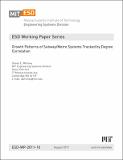| dc.contributor.author | Whitney, Daniel E. | |
| dc.date.accessioned | 2016-06-02T14:32:36Z | |
| dc.date.available | 2016-06-02T14:32:36Z | |
| dc.date.issued | 2011-08 | |
| dc.identifier.uri | http://hdl.handle.net/1721.1/102830 | |
| dc.description.abstract | Urban transportation systems grow over time as city populations grow and move and their transportation needs evolve. Typical network growth models, such as preferential attachment, grow the network node by node whereas rail systems grow by adding entire lines with all their nodes. The objective of this paper is to see if any canonical regular network forms capture the growth patterns of urban metro systems for which we have historical data in terms of old maps. Data from these maps reveal that the systems’ Pearson degree correlation grows increasingly toward positive values over time and in some cases becomes decidedly positive. We have derived closed form expressions for degree correlation and clustering coefficient for a variety of canonical forms that might be similar to metro systems. Of all those examined, only a few types patterned after a wide area network (WAN) with a “core-periphery” structure show similar behavior of the degree correlation as network size increases. This suggests that large metro systems either are designed or evolve into the equivalent of message carriers that seek to balance travel between arbitrary node-destination pairs with avoidance of congestion in the central regions of the network. | en_US |
| dc.language.iso | en_US | en_US |
| dc.publisher | Massachusetts Institute of Technology. Engineering Systems Division | en_US |
| dc.relation.ispartofseries | ESD Working Papers;ESD-WP-2011-10 | |
| dc.title | Growth Patterns of Subway/Metro Systems Tracked by Degree Correlation | en_US |
| dc.type | Working Paper | en_US |
